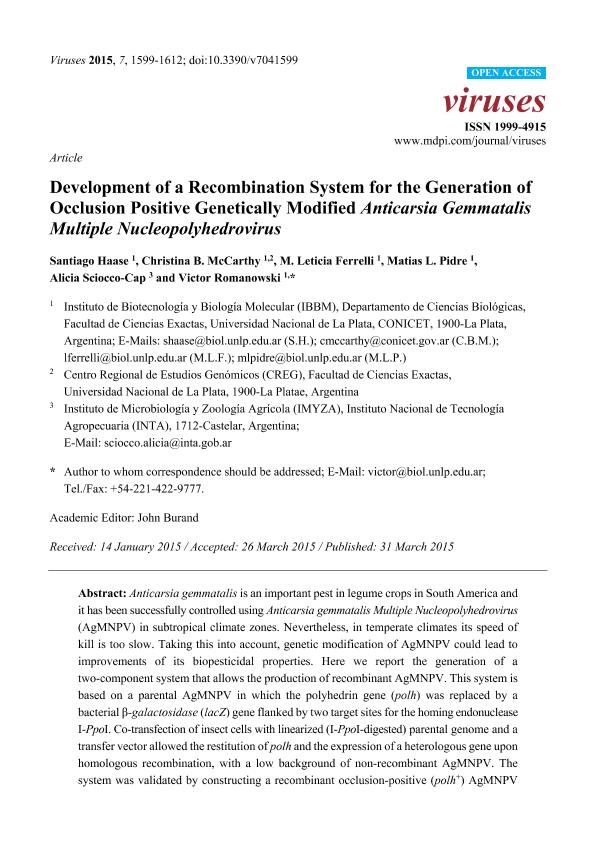Mostrar el registro sencillo del ítem
dc.contributor.author
Haase, Santiago

dc.contributor.author
McCarthy, Christina
dc.contributor.author
Ferrelli, Maria Leticia

dc.contributor.author
Pidre, Matias Luis

dc.contributor.author
Sciocco Cap, Alicia
dc.contributor.author
Romanowski, Victor

dc.date.available
2018-06-08T20:37:12Z
dc.date.issued
2015-03
dc.identifier.citation
Haase, Santiago; McCarthy, Christina; Ferrelli, Maria Leticia; Pidre, Matias Luis; Sciocco Cap, Alicia; et al.; Development of a Recombination System for the Generation of Occlusion Positive Genetically Modified Anticarsia Gemmatalis Multiple Nucleopolyhedrovirus; MDPI; Viruses; 7; 4; 3-2015; 1599-1612
dc.identifier.issn
1999-4915
dc.identifier.uri
http://hdl.handle.net/11336/47999
dc.description.abstract
Anticarsia gemmatalis is an important pest in legume crops in South America and it has been successfully controlled using Anticarsia gemmatalis Multiple Nucleopolyhedrovirus (AgMNPV) in subtropical climate zones. Nevertheless, in temperate climates its speed of kill is too slow. Taking this into account, genetic modification of AgMNPV could lead to improvements of its biopesticidal properties. Here we report the generation of a two-component system that allows the production of recombinant AgMNPV. This system is based on a parental AgMNPV in which the polyhedrin gene (polh) was replaced by a bacterial β-galactosidase (lacZ) gene flanked by two target sites for the homing endonuclease I-PpoI. Co-transfection of insect cells with linearized (I-PpoI-digested) parental genome and a transfer vector allowed the restitution of polh and the expression of a heterologous gene upon homologous recombination, with a low background of non-recombinant AgMNPV. The system was validated by constructing a recombinant occlusion-positive (polh+) AgMNPV expressing the green fluorescent protein gene (gfp). This recombinant virus infected larvae normally per os and led to the expression of GFP in cell culture as well as in A. gemmatalis larvae. These results demonstrate that the system is an efficient method for the generation of recombinant AgMNPV expressing heterologous genes, which can be used for manifold purposes, including biotechnological and pharmaceutical applications and the production of orally infectious recombinants with improved biopesticidal properties.
dc.format
application/pdf
dc.language.iso
eng
dc.publisher
MDPI
dc.rights
info:eu-repo/semantics/openAccess
dc.rights.uri
https://creativecommons.org/licenses/by-nc-sa/2.5/ar/
dc.subject
Agmnpv
dc.subject
Recombinant Baculovirus
dc.subject
Bioinsecticide
dc.subject
Anticarsia Gemmatalis
dc.subject
Velvetbean Caterpillar
dc.subject.classification
Otras Ciencias Biológicas

dc.subject.classification
Ciencias Biológicas

dc.subject.classification
CIENCIAS NATURALES Y EXACTAS

dc.title
Development of a Recombination System for the Generation of Occlusion Positive Genetically Modified Anticarsia Gemmatalis Multiple Nucleopolyhedrovirus
dc.type
info:eu-repo/semantics/article
dc.type
info:ar-repo/semantics/artículo
dc.type
info:eu-repo/semantics/publishedVersion
dc.date.updated
2018-06-08T14:25:31Z
dc.journal.volume
7
dc.journal.number
4
dc.journal.pagination
1599-1612
dc.journal.pais
Suiza

dc.journal.ciudad
Basilea
dc.description.fil
Fil: Haase, Santiago. Consejo Nacional de Investigaciones Científicas y Técnicas. Centro Científico Tecnológico Conicet - La Plata. Instituto de Biotecnología y Biología Molecular. Universidad Nacional de La Plata. Facultad de Ciencias Exactas. Instituto de Biotecnología y Biología Molecular; Argentina
dc.description.fil
Fil: McCarthy, Christina. Consejo Nacional de Investigaciones Científicas y Técnicas. Centro Científico Tecnológico Conicet - La Plata. Instituto de Biotecnología y Biología Molecular. Universidad Nacional de La Plata. Facultad de Ciencias Exactas. Instituto de Biotecnología y Biología Molecular; Argentina. Universidad Nacional de La Plata. Centro Regional de Estudios Genómicos; Argentina
dc.description.fil
Fil: Ferrelli, Maria Leticia. Consejo Nacional de Investigaciones Científicas y Técnicas. Centro Científico Tecnológico Conicet - La Plata. Instituto de Biotecnología y Biología Molecular. Universidad Nacional de La Plata. Facultad de Ciencias Exactas. Instituto de Biotecnología y Biología Molecular; Argentina
dc.description.fil
Fil: Pidre, Matias Luis. Consejo Nacional de Investigaciones Científicas y Técnicas. Centro Científico Tecnológico Conicet - La Plata. Instituto de Biotecnología y Biología Molecular. Universidad Nacional de La Plata. Facultad de Ciencias Exactas. Instituto de Biotecnología y Biología Molecular; Argentina
dc.description.fil
Fil: Sciocco Cap, Alicia. Instituto Nacional de Tecnología Agropecuaria. Centro de Investigación en Ciencias Veterinarias y Agronómicas. Instituto de Microbiología y Zoología Agrícola; Argentina
dc.description.fil
Fil: Romanowski, Victor. Consejo Nacional de Investigaciones Científicas y Técnicas. Centro Científico Tecnológico Conicet - La Plata. Instituto de Biotecnología y Biología Molecular. Universidad Nacional de La Plata. Facultad de Ciencias Exactas. Instituto de Biotecnología y Biología Molecular; Argentina
dc.journal.title
Viruses
dc.relation.alternativeid
info:eu-repo/semantics/altIdentifier/doi/https://dx.doi.org/10.3390/v7041599
dc.relation.alternativeid
info:eu-repo/semantics/altIdentifier/url/http://www.mdpi.com/1999-4915/7/4/1599
Archivos asociados
